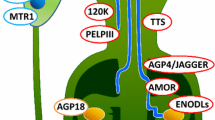Abstract
Sexual plant reproduction is a complex process that involves a series of interactions between the male gametophyte and the different cell types of the pistil. These interactions are believed to direct the pollen tube growth until its final target, the embryo sac. Arabinogalactan proteins are complex proteoglycans that are believed to be involved in these processes. The pistil is enriched in these highly glycosylated proteins and we provide results that show the selective presence of different AGP epitopes at the surface of the cells or in the ECM of the tissues that correspond exactly to the pollen tube growth pathway in Amaranthus hypochondriacus and Actinidia deliciosa. We also show that in Actinidia deliciosa, which is a dioecious plant with the male flowers having rudimentary ovaries where fertilization does not occur, there is no presence at all of the epitopes recognised by the monoclonal antibodies utilized in this study.
Similar content being viewed by others
References
Cheung, A.Y. & H. Wu, 1999. Arabinogalactan proteins in plant sexual reproduction. Protoplasma 208: 87–98.
Cheung, A.Y., H. Wang & H. Wu, 1995. A floral transmitting tissue-specific glycoprotein attracts pollen tubes and stimulates their growth. Cell 82: 383–393.
Coimbra, S. & R. Salema, 1997. Immunolocalization of arabinogalactan proteins in Amaranthus hypochondriacus L. ovules. Protoplasma 199: 75–82.
Coimbra, S. & R. Salema, 1999. Ultrastructure of the embryo sac development in Amaranthus hypochondriacus L. Ann Botany 84: 781–789.
Du, H., RJ. Simpson, A.E. Clarke & A. Bacic, 1996. Molecular characterization of a stigma-specific gene encoding an arabinogalactan-protein (AGP) from Nicotiana alata. Plant J 9: 313–323.
Du, H., R.J. Simpson, R.L. Moritz, A.E. Clarke & A. Bacic, 1994. Isolation of the protein backbone of an arabinogalactan-protein from the styles of Nicotiana alata and characterization of a corresponding cDNA. Plant Cell 6: 1643–1653.
Gao, M., M.J. Kieliszewski, D. Lamport & M. Showalter, 1999. Isolation, characterization and immunolocalization of a novel, modular tomato arabinogalactan-protein corresponding to the LeAGP-1 gene. The Plant J 18: 43–55.
Gell, A.C., A. Bacic, & A.E. Clarke, 1986. Arabinogalactanproteins of the female sexual tissue of Nicotiana alata. Plant Physiol 82: 885–889.
Higashiyama, T., S. Yabe, N. Sasaki, Y. Nishimura, S. Miyagishima, H. Kuroiwa & T. Kuroiwa, 2001. Pollen tube attraction by the synergid cell. Science 293: 1480–1483.
Hopping, M.E. & E.M. Jerram, 1979. Supplementary pollination of tree fruits. NZ J Agri Res 23: 509–515.
Knox, J.P, 1997. The use of antibodies to study the architecture and developmental regulation of plant cell walls. Int Rev Cytol 171: 79–120.
Lind, J.L., A. Bacic, A.E. Clarke & M.A. Anderson, 1994. A stylespecific hydroxyproline-rich glycoprotein with properties of both extensins and arabinogalactan proteins. The Plant J 6: 491–502.
National Research Council, 1984. Amaranth, Modern Prospects for an Ancient Crop. Natinal Academy Press, Washington D.C.
Reger, B., R. Chaubal & R. Pressey, 1992. Chemotropic responses by pearl millet pollen tubes. Sex Plant Reprod 5: 47–56.
Serpe, M.D. & E.A. Nothnagel, 1994. Effects of Yariv phenylglycosides on Rosa cell suspensions: evidence for the involvement of arabinogalactan-proteins in cell proliferation. Planta 193: 542–550.
Serpe, M.D. & E.A. Nothnagel, 1995. Fractionation and structural characterization of arabinogalactan-proteins from the cell wall of rose cells. Plant Physiol 109: 1007–1016.
Sommer-Knudsen, J., W.M. Lush, A. Bacic & A.E. Clarke, 1998. Re-evaluation of the role of a transmitting tract-specific glycoprotein on pollen tube growth. The Plant J 13: 529–535.
Testolin, R., G. Cipriani & R. Messina, 1999. Sex control is monofactorial and remains so in polyploids. In: Sex Determination in Plants. Bios Scientific Publisher. Oxford, Washigton DC.
Wang, H., H. Wu & A.Y. Cheung, 1993. Development and pollination regulated accumulation and glycosylation of a stylar transmitting tissue-specific proline-rich protein. Plant Cell 5: 1639–1650.
Wang, H., H. Wu & A.Y. Cheung, 1996. Pollination induces m-RNA poly(A) tail-shortening and cell deterioration in flower transmitting tissue. Plant J 7: 715–727.
Wu, H., H. Wang & A.Y. Cheung, 1995. A pollen tube growth stimulatory glycoprotein is deglycosylated by pollen tubes and displays a glycosylation gradient in the flower. Cell 82: 395–403.
Wu, H., E. Wong, J. Ogdahl & A.Y. Cheung, 2000. A pollen tube growth-promoting arabinogalactan protein from Nicotiana alata is similar to the tobacco TTS protein. The Plant J 22: 165–176.
Yates, E.A., J-F. Valdor, S.M. Haslam, H.R. MorriS, W. Mackie & J.P. Knox, 1996. Characterization of carbohydrate structural features recognized by anti-arabinogalactan-protein monoclonal antibodies. Glycobiology 6: 131–139.
Author information
Authors and Affiliations
Rights and permissions
About this article
Cite this article
Coimbra, S., Duarte, C. Arabinogalactan proteins may facilitate the movement of pollen tubes from the stigma to the ovules in Actinidia deliciosa and Amaranthus hypochondriacus . Euphytica 133, 171–178 (2003). https://doi.org/10.1023/A:1025564920478
Issue Date:
DOI: https://doi.org/10.1023/A:1025564920478




